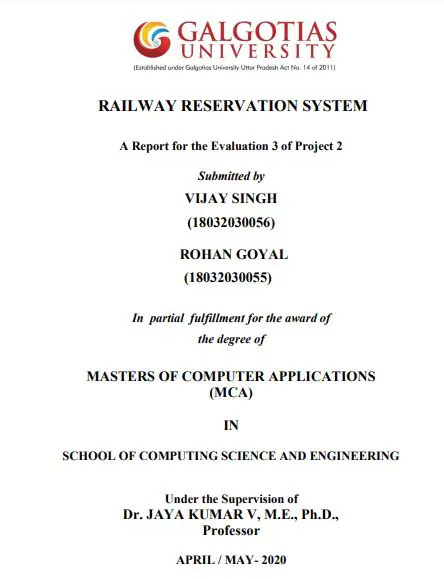‘Railway Reservation System Report’ PDF Quick download link is given at the bottom of this article. You can see the PDF demo, size of the PDF, page numbers, and direct download Free PDF of ‘Project On Railway Ticket Reservation System’ using the download button.
Railway Reservation System Project Report PDF Free Download

Railway Reservation System: INTRODUCTION
1.1 History
A plan for a rail system in India was first put forward in 1832, but no further steps were taken for more than a decade.
In 1844, the Governor-General of India Lord Hardinge allowed private entrepreneurs to set up a railway system in India.
Two new railway companies were created and the East India Company was asked to assist them.
Interest from a lot of investors in the UK led to the rapid creation of the rail system over the next few years.
Railways were first introduced to India in 1853. By 1947, the year of India’s independence, there were forty-two rail systems.
In 1951 the systems were nationalised as one unit, becoming one of the largest networks in the world.
IR operates both long-distance and suburban rail systems on a multi-gauge network of broad, metre and narrow gauges.
It also owns locomotive and coach production facilities.
The first train in India become operational on 1851-12-22 and was used for the hauling of construction material in Roorkee.
A few years later, on 1853-04-16, the first passenger train Bori Bunder, Bombay and Thana covering a distance of 34 km (21 miles) was inaugurated formally heralding the birth of railways in India.
1.2 Introduction To The Reservation System
The Indian Railways (IR) carries about 5.5 lakh passengers in reserved accommodations every day.
The computerised Passenger Reservation System(PRS) facilities the booking and cancelling of tickets from any of the 4000 terminals (i.e. PRS booking windows) all over the country.
These tickets can be booked or cancelled for journeys commencing in any part of India and ending in any other part, with travel times as long as 72 hours and distances up to several thousand kilometres.
The pilot project of PRS was launched on 15 November 1985, over Northern Railway with the installation of the integrated Multiple Train Passenger Reservation System (IMPRESS), an online transaction processing system developed by the Indian Railways in association with the Computer Maintenance Corporation (CMC) ltd, at New Delhi.
The objective was to provide reserved accommodation on any train from any counter, preparation of train charts and account for the money collected.
The applications was subsequently implemented in 1987, in Mumbai, Chennai, Kolkata and Secunderabad with the additions of new locations and many redefinitions, the IMPRESS system fell short of the growing expectations of the travelling public.
1.2.1 RAILWAY RESERVATION METHODS:
✓ Online Booking
✓ Counter Booking
Online Booking:
This facility is given to the general public by the Railway department with the help of this facility people can book their tickets through the internet, sitting in their homes with a single click of the mouse.
Using their credit card or debit card people can easily get their tickets done within minutes. There are certain charges for online booking as well.
Counter Booking:
This is the oldest method of booking a ticket.
The Reservation counters are there at Railway departments from where people can get the tickets to their respective destinations.
Nowadays there are various ticket counters, apart from the railway station counters where tickets are available.
1.3 OUR PROJECT:
This project introduces the railway reservation system. It explains how the reservation is being done in Indian Railways.
The step-by-step procedure is explained.
This project is developed in C++ language. Almost all the Header files have been used in this project.
Proper comments have been given at desired locations to make the project user-friendly. Various functions and structures are used to make complete use of the language.
This project is well-versed in programming.
Railway reservations can easily be accompanied with the help of this.
The basic functions being performed by our systems are:
- RESERVATION MANAGEMENT
- FARE MANAGEMENT
- TIME TABLE MANAGEMENT
These functions will be handled with the help of the following sub-functions:-
• It reserves and cancels seats for the passenger.
• It contains information about the trains.
• It contains information about the passenger.
• It contains the details of a reservation fee, any concessions etc.
• It makes entries for reservation, waiting, and cancelled tickets.
• It will update for uptime and downtime trains.
1.4 EXISTING SYSTEM
Under the existing system, passengers were only provided with a list of trains between two stations and the train number is only the available information by which they can take action.
Under the existing system, passengers were not able to get information on their arrival and departure and the route by which particular trains will travel.
Passengers were only able to select the seat number and were not provided which seat type they want to select and this sometimes not creates a familiar environment during their journey.
During making payment final validation and authorization were done by the system to identify the particular passenger to make a deduction for their fare charges to make the final reservation.
| Author | – |
| Language | English |
| No. of Pages | 30 |
| PDF Size | 9 MB |
| Category | Project Report |
| Source/Credits | bitstream.com |
Railway Reservation System Project Report PDF Free Download
